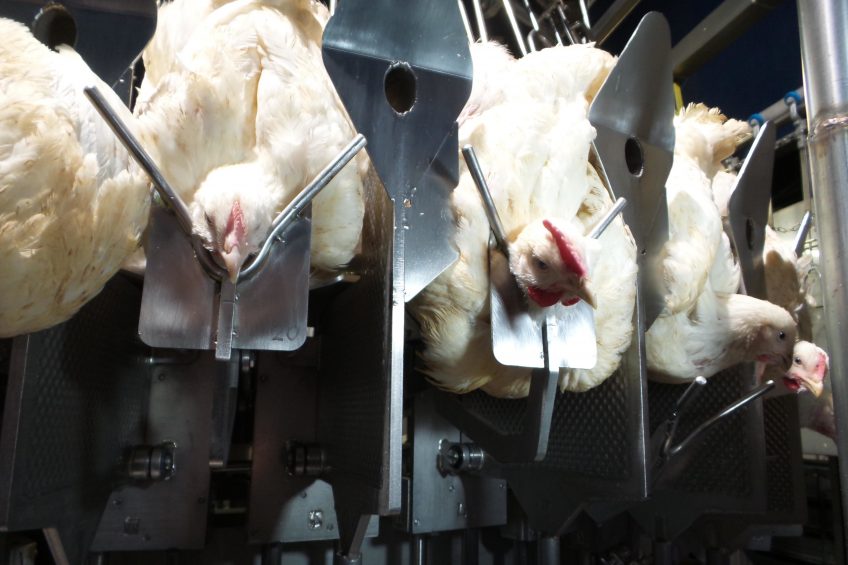Head-only stunning offers alternative to gas

Many consider water bath or controlled atmosphere stunning to be the two best choices when choosing ways to render poultry unconscious before a more welfare-friendly kill. But one Dutch company is marketing an alternative, stunning poultry by the head individually.
European poultry processors have trended towards using controlled atmosphere stunning and always using water baths for a number of years, and in some ways it’s easy to see why. Birds are not handled before stunning in such systems, making their final moments less stressful – and the process is less stressful for employees as well, who only deal with unconscious livestock.
Conventional water bath stunning has been considered by some to be of lower welfare for some time – one piece of research has suggested that just a third of broilers passing though are effectively stunned. Whatever the exact figure, running a current through water to stun multiple birds is not an exact science. Doing so creates a ‘parallel pathway of resistance’, and understanding which birds have been effectively stunned before slaughter is in no way easy. All the more challenging was the European Union introducing new legislation (1099/2009 Watok), setting higher parameters for stunning poultry before slaughter.
Halal challenges
While this move was welcomed by some, for Halal producers it proved a potential challenge – the new parameters were too high for birds to recover effectively. Gas stunning is also out of the question, as it also delivers a stun animals will never recover from. In Western Europe it is common for poultry to be ‘recoverably stunned’ before slaughter – acceptable to many who follow Islam in this region; it is a far smaller percent that choose only totally unstunned animals.
It was around 2009 that Michel Schmidt set up Dutch Vision Solutions, following a career in poultry processing. A contact concerned about the difficulties Halal producers faced got in touch, and asked him to develop a new machine that would allow poultry to be recoverably stunned using the new parameters. The answer, says Mr Schmidt, was individually stunning birds. “A high production capacity was important,” he explains. “And I wanted a machine that could process up to 3kg live weight and at least 12,000 birds an hour.”

From that initial conversation, a machine capable of processing 13,500 birds an hour was produced. It is compatible with both six-and eight-inch lines, and the weight spread of a batch of broilers can be up to 700g before adjustment is needed. Furthermore, it has a footprint of 16 square meters – smaller than most controlled atmosphere stunning machines on the market. Testing has found it to be 96.5% accurate at full speed, but combined with a splitting device that diverts any unstunned birds to a conventional water bath, also devised by Dutch Vision Solutions, this goes up more than 99% accuracy.
Cost
Another key consideration, says Mr Schmidt, is cost (see table). He points to research undertaken by the European Commission as it was introducing its new stunning parameters that considered the cost of different stunning methods. Water bath stunning was least expensive, with gas stunning the most. In between was the head-only stun method, cheaper because of its lower maintenance and running costs, when compared with gas systems. While it was the difficulty that new legislation in Europe presented to halal processors that wanted a recoverable stun, Mr Schmidt says the resulting equipment is an improvement on water bath stunning, and comparable to gas devices. “Given the greater amount of A-grade product, the benefits are more than sufficient to cope with the more expensive price when compared with a water bath.” “Blood spots are almost non-existent,” he says. “And it’s the same with major haemorrhaging around wing points.”
Wageningen research: Testing head-only stunning
Dutch Vision Solutions asked Wageningen University to review its stunning technology under lab conditions. The first step was to evaluate the machine’s efficacy. Thirty-eight broilers were stunned by an electrical constant current set at 275mA for 1 second, followed by a current of 30mA for three seconds. It was considered these parameters delivered an effective stun. A second experiment was geared at understanding the machine’s efficacy at commercial slaughterhouse conditions, to ensure that stunning renders birds unconscious and they remain so until slaughter.
The experiment was conducted at 13,500 birds/hour to mimic normal operating conditions, and 200 birds over two days were assessed from seven different flocks. The stun was judged by reaction to stimuli. The study found more than 95% of birds were effectively stunned, with 4.5% showing some reaction 30 seconds post-stun. Based on these results, it was recommended that birds are killed no more than 30 seconds after stun. An in-line back-up system, such as the splitter device also developed by Dutch Vision Solutions, was also considered important.
Marketing
His head-only stunning system, built in the Netherlands, is now on the market, and orders are progressing with Dutch slaughterhouses. But it’s the global market that Mr Schmidt ultimately has his eye on. In the US, he considers the growing trend towards higher welfare product as a potential opportunity. “In America, they don’t have the 240mA limit. But, if you look at what’s happening with animal welfare awareness, that might be a selling point.” Another region is countries keen to import to Europe, such as Brazil, that have been caught out with the new WATOK regulations, and lost market as a result.
Finally, Mr Schmidt feels the trend to recoverably stun could spread to regions where it is currently not common, such as the Middle East. “We think that this is the best alternative to gas systems – nobody wants water bath stunning anymore, at least in the EU. We’ve proven with this machine that there is an option if you cannot use gas, either for halal reasons, or you don’t have the space.”









